More than 6,500 lizard species inhabit our planet; these reptiles are incredibly varied and fascinating. Lizards offer a unique experience in pet-keeping, combining exotic wildlife’s charm with the joy of having a pet. Choosing the right lizard is important for a manageable pet experience, especially for beginners. And with so many species available, the choice can be daunting.
Lizards range from the peaceful Bearded Dragon to the energetic Leopard Gecko, catering to all lifestyles. When picking your lizard friend, think about the following:
- Temperament: Look for calm and friendly lizards that are great for handling.
- Variety: There’s a wide choice of sizes and colors.
- Activity and Behavior: Enjoy watching their interesting climbing and moving around.
- Lifespan: Be prepared for a long-term commitment lasting 8-30 years.
- Size and Space Requirements: Smaller lizards fit better in small spaces, but larger ones need more room.
Excited to find your perfect reptile match? Let’s delve into the fascinating world of pet lizards!
Top 9 Best Beginner Pet Lizards
Now, informed by the traits identified above, we can begin to pinpoint a few of the best lizards for beginners. There are still important differences between each, so you should make sure to consider the specific needs of any pet you intend on keeping. Then, imagine yourself satisfying them on a day-in-day-out basis for the next several years (or decades, depending on the species you choose).
With that said, the following five lizard species make great pets for beginners (listed in no particular order):
- Leopard Gecko
- Bearded Dragon
- Crested Gecko
- Anoles
- Blue Tongue Skink
- Red-Eye Crocodile Skink
- Ackie’s Monitor
Now that we’ve identified the best pet lizard species for beginners, it is time to discuss the basic requirements of these species and some of the reasons they make such good pets.
1. Leopard Gecko: A Very Cute Pet Lizard
| Characteristic | Detail |
| Scientific Name | Eublepharis macularius |
| Lifespan | Up to 20 years in captivity |
| Adult Size | 7 to 11 inches |
| Adult Weight | 50-80 grams |
| Tank Size | At least 20 gallons |
If you asked 100 experienced lizard keepers to recommend a good pet lizard for beginners, 95 of them would probably agree that a leopard gecko (Eublepharis macularius) is the best option. In large part, this is due to the fact that leopard geckos satisfy most of the criteria discussed earlier.
For example, leopard geckos will thrive on a diet of crickets and mealworms, they are bred in incredible numbers each year, and they are tolerant of a wide range of temperature and humidity levels. They are a bit on the small side (particularly while young), so beginners are wise to select a specimen that is already several months old.
Most importantly, leopard geckos are nocturnal lizards, who do not require any special lighting. In fact, you needn’t provide them with any supplemental light at all if you use heat pads or heat tape to manage the enclosure temperatures.
Leopard geckos are usually pretty easy-going lizards, who rarely attempt to bite their keepers. They aren’t as easy to handle as some of the other lizards discussed below, but beginners shouldn’t have many problems trying to handle these geckos.
Additionally, leopard geckos are available in a diverse array of color and patterns. This means you can pick up a leopard gecko that looks drastically different than your buddy’s pet leopard gecko. They’re also pretty easy to breed, which may appeal to prospective keepers who think they may want to eventually try their hand at captive reproduction.
We’ve written about the care requirements of leopard geckos before, so be sure to check out our comprehensive review of the subject here.
Reasons leopard geckos make good pets for beginners:
- Easy to feed
- Hardy and tolerant of a fairly wide range of temperatures
- No special lighting required
- Generally calm and easy to handle
- Small lizards who require small habitats
2. Bearded Dragon: The Coolest Pet Lizard
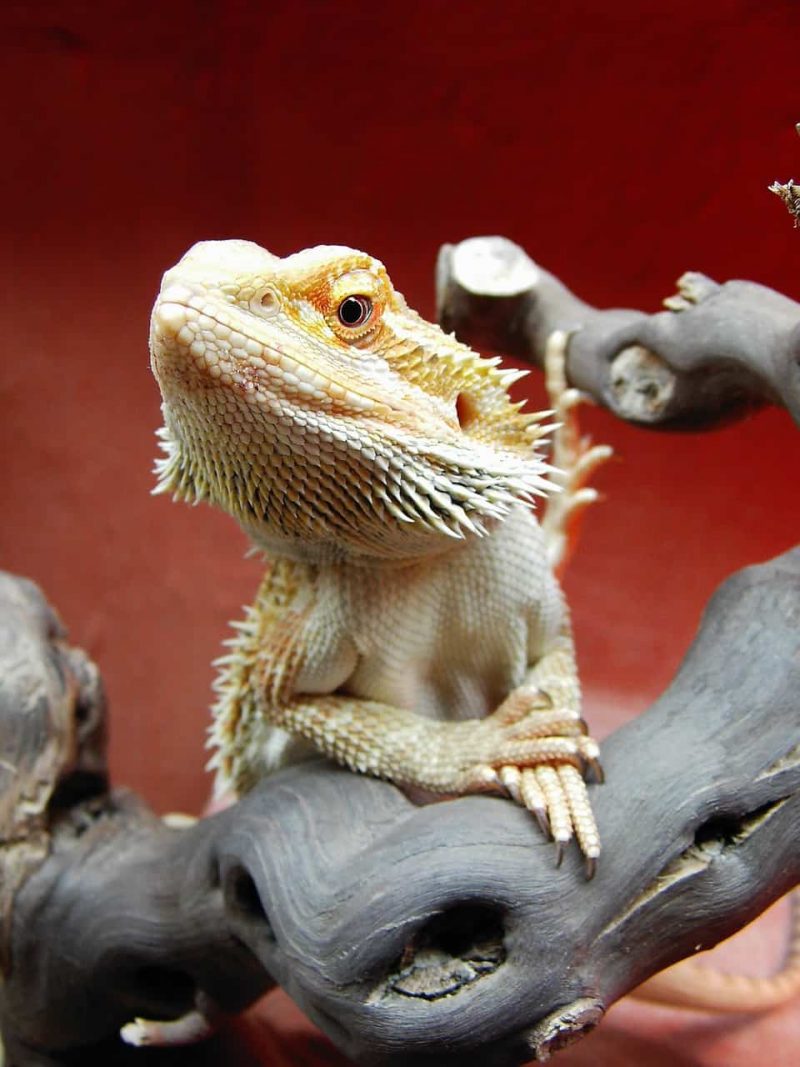
| Characteristic | Detail |
| Scientific Name | Pogona vitticeps |
| Lifespan | 8-10 years in captivity |
| Adult Size | 16-24 inches |
| Adult Weight | 300-500 grams |
| Tank Size | Minimum 55 gallons |
Bearded dragons (Pogona vitticeps) are certainly hardy and relatively easy to care for, so they make a pretty good choice for first-time lizard keepers. They do present a few challenges that some of the other lizards on this list do not, but their positive traits help to mitigate them.
For starters, bearded dragons are some of the most docile lizards available in the pet trade. There are occasional “bad apples,” but the vast majority of bearded dragons are calm and largely indifferent to their keepers. They also reach a good size for those who intend on handling their pet often – most adults are about 16 to 18 inches in length.
Thousands (likely tens of thousands) of bearded dragons are produced in the U.S. and Europe each year, so they’re readily available, and they inhabit arid regions, so they tolerate temperature swings and varying humidity levels pretty well.
Nevertheless, bearded dragons present two challenges beginners must consider before deciding to work with this species. Bearded dragons are sun-loving lizards, who require UVB-producing lights or frequent opportunities to bask outdoors to remain healthy. But, as long as you familiarize yourself with the finer points of lighting, you can likely succeed with this species.
Bearded dragons are also omnivores, so you’ll need to research their dietary needs carefully before adding one to your family. They primarily subsist on crickets and other invertebrates while they are young, but fruits and vegetables should make up about 50% to 75% of the diet of adults.
Note that bearded dragons will require relatively large enclosures as adults. Something with about 6 to 8 square feet of space is typically appropriate.
We’ve discussed bearded dragons in greater depth before, so be sure to check out our comprehensive guide to bearded dragon care here.
Reasons bearded dragons make good pets for beginners:
- Very calm and docile
- Captive-bred individuals are easy to find
- Available in several colors and patterns
- Large, but not too large
- Very hardy lizards who tolerate keeper mistakes well
3. Crested Gecko: An Easy-to-Feed Pet Lizard
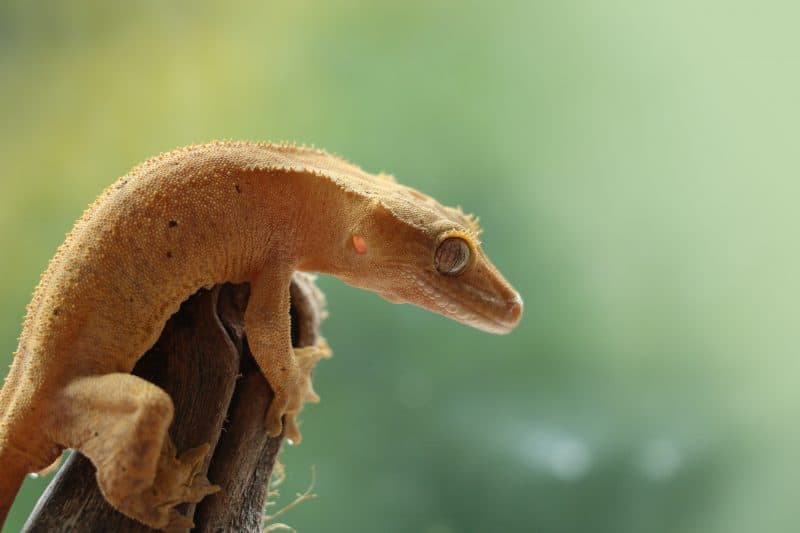
If the leopard gecko is deserving of the title of “Best Lizard Pet for Beginners,” then the crested gecko (Correlophus ciliatus) is likely the runner up. Crested geckos are newer to the reptile-keeping scene than most of the other species listed here, as they were long thought extinct, and only rediscovered a few decades ago. But it’s easy to see why they’ve become so popular with lizard enthusiasts.
Crested geckos are nocturnal lizards, so they don’t require any special lighting to remain healthy. In fact, they also tend to thrive in the same type of temperature range that you prefer in your home. So, heating devices are not always necessary either. Both of these factors make the lizards a great option for beginners.
But the trait that has likely boosted their popularity more than any other is their ability to subsist on a commercial diet. Crested geckos consume a lot of insects in the wild, and most keepers provide their pets with a few bugs from time to time. However, they also eat a lot of flower nectar and fruit.
But you needn’t even provide your pet with these things – you can simply feed a crested gecko on a commercially produced food that mimics these items instead. In fact, some breeders have raised multiple generations of crested geckos solely on a commercial diet.
They aren’t the easiest lizards to handle in the world, and keepers must take great care to avoid touching their pet’s tail. Nevertheless, they remain one of the best choices available to beginners.
We’ve written about crested geckos before and discussed the things they need from their keeper to thrive. Be sure to check out our crested gecko care guide to learn more about the species.
Reasons crested geckos make good pets for beginners:
- Very easy to feed – you can even give them commercially produced foods
- Most individuals for sale are captive bred
- Available in a number of colors and patterns
- No special lighting required
- Thrive at room temperature
4. Anole: A Small Pet Lizard

Despite the fact that they make very unassuming pets, anoles are often overlooked by prospective lizard keepers. This is likely because they are relatively small and common throughout portions of the United States, but new keepers would be wise to ignore these drawbacks and give anoles (Anolis ssp.) serious consideration.
There are a variety of different anole species available; depending on the authority consulted, there are between 40 and more than 400 described species. However, a handful of species, including the knight anole (A. equestris), Jamaican anole (A. garmani) and the U.S.-native green anole (A. carolinensis), are the some of the most widely available species. Knight and Jamaican anoles are bred somewhat regularly, and keepers who don’t mind hunting around a bit can usually find captive-bred green anoles too.
Anoles are thought to need UVB light, so you’ll need to provide them with proper lighting. However, they offer relatively few other problems. Most will thrive on a cricket-based diet, and the larger species are a good size for beginners. They also make excellent subjects for elaborately planted vivaria, rather than the spartan, “sterile” habitats that work best with some other species.
You will have to pay attention to the thermal environment you provide to your pet, but most anoles are capable of tolerating the mistakes beginners often make. They also require slightly high humidity levels, but once again, they aren’t as demanding in their requirements as some other species are.
Anoles exhibit varying temperaments, but even those that are somewhat defensive are usually relatively easy to handle.
Reasons anoles make good pets for beginners:
- Most will thrive on an insect-based diet
- Generally easy to handle when necessary
- Readily available and affordable
- Great for naturalistic vivaria
- Small lizards who can thrive in relatively small habitats
5. Blue Tongue Skink: A Friendly Pet Lizard
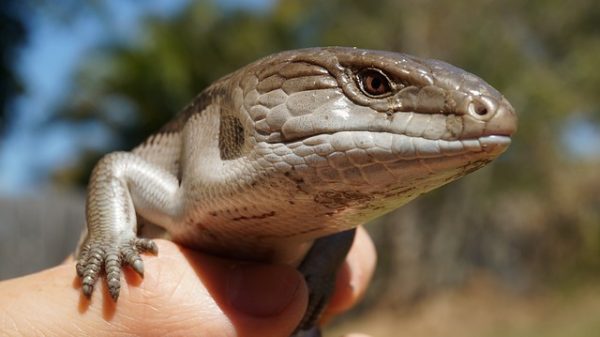
| Characteristic | Detail |
| Scientific Name | Tiliqua |
| Lifespan | 15 – 20 years |
| Adult Size | 1.25 to 2 feet |
| Adult Weight | 283-510 grams |
| Tank Size | 30-40-gallon |
General Description: Blue tongue skinks (Tiliqua ssp.) are a great option for those interested in handling their new pet, as they’re typically laid back and rarely exhibit defensive behaviors. They also reach sizes that are well-suited for handling – most adults are between 18 and 20 inches long (although some species reach slightly larger sizes).
It isn’t entirely clear whether or not blue tongue skinks require UVB lighting. Some keepers provide their lizards with light that is similar to that provided to bearded dragons and similar species, while other keepers maintain their lizards without any special lighting at all. Most blue tongue skinks will also tolerate a range of humidity levels, although most will benefit from a damp hide into which they can retreat from time to time.
Feeding blue-tongue skinks is also pretty easy. They’re omnivores who thrive best on a varied diet consisting of vegetables, fruits, insects, and the occasional pre-killed or frozen-thawed rodent. However, you can supplement a significant portion of their diet with commercially manufactured foods (which are largely similar to canned cat food).
It is important to ensure that beginners start with a captive-bred individual rather than a wild-caught specimen. Wild-caught individuals probably outnumber captive-bred specimens in the marketplace, but they are bred in large numbers, so it is rarely difficult to find ones that have been produced by breeders.
Reasons blue tongue skinks make good pets for beginners:
- Tolerant of a range of humidity levels
- Very calm and easy to handle
- Large, but not too large
- Captive-bred individuals are often easy to find
- Their broad diets make them easy to feed
6. Red-Eyed Crocodile Skink: A Dragon-Looking Pet Lizard
| Characteristic | Detail |
| Scientific Name | Tribolonotus gracilis |
| Lifespan | 10 to 14 years |
| Adult Size | 7 to 9 inches in length |
| Adult Weight | 36 to 45 grams |
| Tank Size (in gallons) | At least 10 gallons |
General Description: The Red-Eyed Crocodile Skink looks like a tiny dragon. It has a strong body, dark brown and cream colors on its underbelly, and bright reddish-orange scales around its eyes. Its unique look is making it more popular.
Reasons blue tongue skinks make good pets for beginners:
They eat small insects, which should be coated with reptile vitamins and calcium. They like a tropical setting with lots of humidity, ideally between 70% and 90%. And they need it warm during the day, around 82 to 84 degrees Fahrenheit & not below 70 degrees at night. Keeping their environment right needs some attention – but it’s doable for beginners. These skinks are shy and shouldn’t be handled too much, as they get stressed easily, and they don’t bite often, which makes them a safe choice for families.
7. Ackie’s Monitor: A Gentle Pet Lizard
| Characteristic | Detail |
| Scientific Name | Varanus acanthurus |
| Lifespan | 15-20 years |
| Adult Size | 24 inches |
| Adult Weight | 141 to 340 grams |
| Tank Size | Juveniles: 40-gallon and Adults: 120-gallon tank |
General Description: Ackie’s Monitor is a striking reptile with a somewhat intimidating appearance, closely related to the Komodo Dragon. These medium-sized lizards come from dry areas in Australia and are loved by reptile fans worldwide.
Reasons blue tongue skinks make good pets for beginners:
Ackie’s Monitors need big homes. They like to burrow, so a thick layer at the bottom of their tank is important. And even though they need this space, they are gentle – making them suitable for beginners. Their tank should have different temperatures, with a warm area up to 100°F and a cooler spot around 82°F. UVB lighting is really important for their health. The humidity in their tank should be between 20-50%, which can be managed with the right substrate and regular misting. They eat various foods, like small rodents, crickets, and mealworms, and need calcium and vitamin supplements.
Ackie’s Monitors have a temperament well-suited for captivity, showing no aggression once comfortable. Regular handling can make them more at ease with human interaction.
Are Lizards Good Pets for Beginners?
There are several different types of reptile that beginners can choose for a first pet, and – candidly – I usually nudge prospective keepers toward snakes. Specifically, I tend to recommend hardy and easy-to-keep species such as ball pythons (Python regius), corn snakes (Pantherophis guttatus guttatus) and common kingsnakes (Lampropeltis getula spp.).
My reasoning is pretty simple: These snake species (and several others) are almost universally easier for novices to care for than the easiest lizards are. The reasons for this will become evident in the next section, as we talk about the traits that characterize the best reptiles for beginners.
But first, it is important to understand that reptile keeping is a completely alien activity for the vast majority of people. Beginners must learn a lot before picking up their first pet. It is a multi-faceted discipline, and it requires a basic understanding of subjects ranging from physics to chemistry to ecology.
When you combine this steep learning curve with the fact that even the most experienced and skilled keepers are occasionally vexed by their animals, it becomes obvious that beginners should always select a species that exhibits as few husbandry challenges as possible.
Fortunately for those with their heart set on a lizard, there are several lizards that can also make great pets for beginners. Not surprisingly, you’ll see that they exhibit a lot of the same traits as the snake species I typically recommend to beginners.
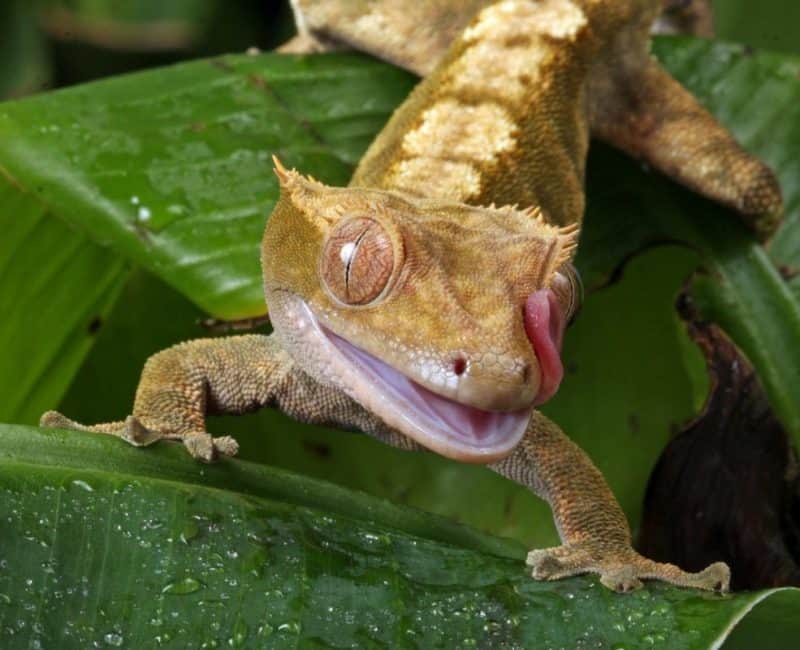
The Nine Hallmarks of a Good Pet Lizard (or Any Other Type of Reptile)
Before we discuss the specific species that make good pets for beginners, it is important to identify the traits that usually make a given species easy to maintain.
In a perfect world, beginners would pick a lizard that exhibits as many of the following traits as possible.
1. Easy to Feed
Feeding most lizards is much different than feeding a pet dog, cat or hamster. Instead of a commercially manufactured kibble, you’ll need to feed the vast majority of pet reptiles “natural foods.” So, it is important that you select a lizard that can subsist on a food you can easily source.
Additionally, note that some lizards have very narrow dietary requirements. Gila monsters (Heloderma ssp.), for example, are egg-eating specialists. Many of the Australian monitor lizards specialize in eating other lizards. And some, such as the beautiful and bizarre caiman lizard (Dracaena guianensis) have special adaptations to facilitate their mollusk-eating lifestyle.
On the other hand, many of the best pet lizards will consume a variety of different foods. Anoles (Anolis ssp.), for example, will usually feed on just about anything wiggly that appears small enough to swallow. Such lizards are obviously much better suited for beginners.
2. Carnivorous
Broadly speaking, lizards fall into one of three dietary categories. Some eat animals, some eat plants, and some eat both.
Those in the final category are almost always a bad idea for beginners. Balancing the nutritional needs of a completely herbivorous lizard is tricky at best, and it is a task that is typically beyond the capabilities of a first-time keeper. On the other hand, omnivorous lizards are easier to feed properly, and completely carnivorous (or insectivorous) are typically the easiest to feed of all.
Insectivorous lizards do, however, saddle the keeper with an additional challenge: You must not only maintain your lizards but, in many cases, their prey too. Nevertheless, keeping a tub full of crickets or mealworms isn’t as difficult for most newcomers as properly designing a vegetarian diet, so bug-eating lizards still make a better choice for beginners in most cases.
3. Tolerate Handling
Most new keepers are at least marginally interested in handling their pet from time to time. Accordingly, it is usually wise for novices to start with a lizard that is calm and tends to take human interaction in stride. This is not only good for the keeper; it is also good for the kept.
Even if you don’t plan on handling your lizard for fun, you’ll usually find it necessary to put your hands on your pet from time to time. If nothing else, you’ll need to maintain his habitat and regularly inspect him for health problems or injuries.
Experienced keepers are often willing to endure any indignities their animals may exhibit, but beginners are usually not comfortable putting their hands on an angry lizard, who is willing to defend itself by biting, scratching or explosively voiding the contents of its cloaca.
4. Tolerate a Wide Range of Humidity Levels
There are a variety of environmental parameters fledgling keepers must learn to manage when keeping pet lizards, but humidity levels are often one of the most difficult.
This is most problematic for those keeping lizards that hail from damp environments. Most homes (even those in the southeast, thanks to indoor air-conditioning) are drier than your average rainforest. This means that keepers must go to great lengths to keep the semi-isolated air in their pet’s habitat suitably saturated.
This presents a host of challenges. You must not only get enough water into the habitat, but you’ll also have to get that water into the air inside the enclosure. But you’ll have to do so while still providing adequate ventilation. And because warm, damp enclosures are veritable Petri dishes, high-humidity habitats are more difficult to keep clean.
Given these factors, it is wise for new keepers to stick to lizards that can tolerate low (or at least varying) humidity levels.
5. Do Not Require Special Lighting
The sun not only pumps out visual light; it also blasts the earth with a lot of light that we can’t see. These types of rays are invisible because they have longer or shorter wavelengths than the human eye can detect. But they exist, and it turns out, they play important roles in the physiology of many lizard species.
It’s a complicated issue that biologists are still working to fully understand, but some lizards rely on sunlight – specifically the light rays with wavelengths between 290 and 320 nanometers – to covert the Vitamin D in their diet to a form that their body can use (termed D3). When deprived of light rays in this range, these lizards often develop serious (and often irreversible) health problems, such as metabolic bone disease.
Typical light bulbs do not produce these necessary wavelengths of light, but you can purchase special lights for keeping reptiles that need these rays. You’ll also need to set the lights up in specific ways and replace them on a consistent schedule to ensure they work properly.
Fortunately, there are a variety of lizards that don’t appear to need this type of special lighting. Most of these lizards are either carnivorous or nocturnal, so you’ll note that several of the lizards recommended below meet one of these two criteria.
6. Desert Dwelling
In addition to humidity, new reptile keepers will need to manage the thermal environment of their pet’s enclosure. This isn’t as difficult as maintaining proper humidity levels, but it is still a challenge for many new keepers.
In practice, beginning keepers will often need a lot of time to learn how to keep the temperatures in their pet’s habitat within the desired range, while still providing a thermal gradient and the proper diel temperature variations.
So, it is generally wise for beginners to select a species that can tolerate a fairly wide range of temperatures. Because deserts and other arid habitats usually experience much greater temperature swings than forests and other damp habitats, desert-dwelling lizards are typically best-suited for beginners.
You’ll still need to provide these animals with a proper thermal environment, but by and large, they’re more forgiving of small errors than their forest-dwelling counterparts.
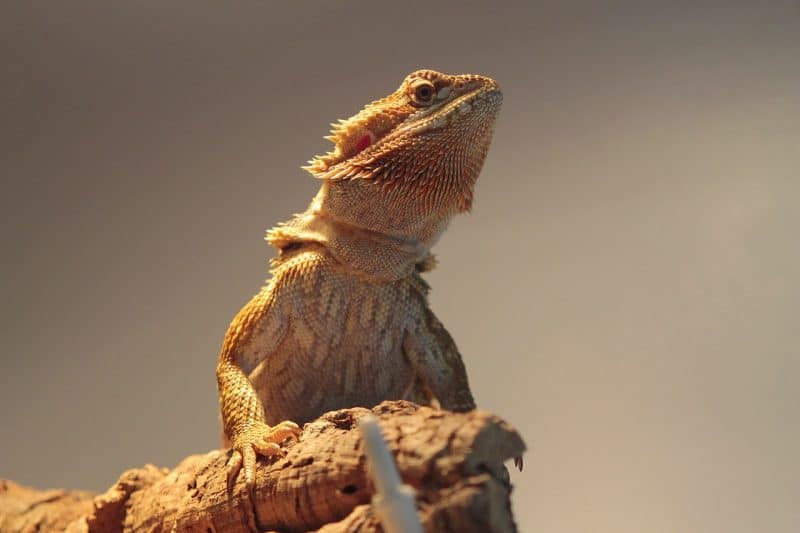
7. Readily Bred in Captivity
It the vast majority of cases, captive-bred lizards make better pets than those who were collected from the wild. Captive-bred individuals are more accustomed to the presence of people, and they’re less likely to have contracted pathogens or parasites than wild-caught lizards. Also, captive-bred individuals haven’t been removed from the wild.
So, given that beginning lizard keepers should always try to limit the challenges facing them, it is wise for novices to start with a species that is readily bred in captivity. This means you won’t have to look very hard to find captive-bred individuals, and it also means that the “formula” for maintaining the species is likely well-established.
Fortunately, there are a number of lizard species that are bred in large numbers, so this is rarely a difficult criterion to satisfy.
8. Reasonable Lifespan
Lifespan is an often-overlooked characteristic among prospective lizard keepers, as well as the more experienced keepers who advise these newcomers. Simply put, you’ll want a lizard that lives long enough to make your husbandry efforts worthwhile, as well as one that doesn’t live so long that you must incorporate him into your long-term plans.
Take, for example, carpet chameleons (Furcifer lateralis). They’re a beautiful and interesting species, but they typically only live for about 1 year – the species simply has a very high natural turnover rate in the wild. They only stick around long enough to hatch from their eggs, eat enough bugs to reach maturity, and then breed. Shortly after, they die off.
So, while some experienced keepers may find it rewarding to maintain a colony of these lizards across multiple generations, most beginners would be disappointed to go to the effort of setting up a proper habitat, figure out how to care for their lizard, only to have it die in a matter of months.
On the other hand, it is wise to avoid lizards that routinely live for excessively long lengths of time. A lizard that normally lives for 20 years may sound appealing in theory, but in practice, it’ll often cause considerable difficulties. In the real world, it can be difficult to imagine your life a mere five or ten years in the future – trying to envision your life two decades from now is rarely possible.
So, beginners are often best served by selecting a species with a 5- to 10-year lifespan in most cases.
9. Reasonable Size
Size is an important consideration for keepers of all experience levels, but it is an especially significant consideration for beginners. Very large and very small lizards both present challenges that may be difficult for beginners to overcome, so it is wise to stick to species that have an adult size that falls between about 8 and 18 inches.
Very small species can be difficult to handle without causing injury, and they are also difficult to feed in many cases. Further, small lizards are more vulnerable to temperature and humidity swings than larger animals are. They often overheat or become dehydrated much more quickly than medium or large lizards do.
At the other end of the spectrum, very large species are simply difficult to house and handle. Take the green iguana, for example. Once hailed as a great pet lizard for beginners, these lizards routinely reach 5 to 7 feet in length. This means they not only need very large accommodations, but they can also inflict moderately serious injuries on their keeper if they become frightened or irritable.
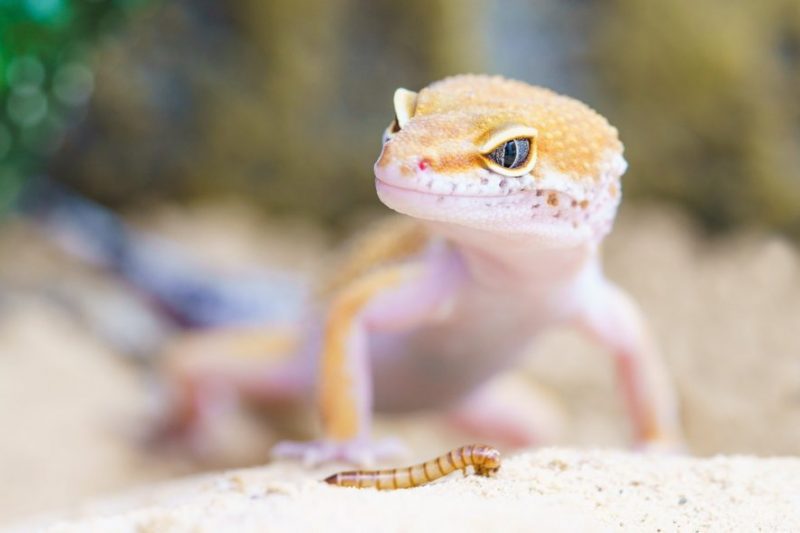
What Is the Most Harmless Lizard?
The most harmless lizard for beginners is the Bearded Dragon. This species stands out for several reasons.
- First, Bearded Dragons are known for being calm and forming close bonds with people who care for them.
- And these lizards are playful and like spending time with humans; once they trust you, they’re even okay with being handled.
- Additionally, Bearded Dragons are not hard to take care of. And they’re one of the most sociable lizard species. This means they’re comfortable around people and enjoy interacting with them.
Are Lizards Easy To Take Care Of?
Lizards can be great pets, but they need special care. They’re different from usual pets like cats or dogs. They have their own needs, from what they eat to where they live.
For example: Bearded Dragons are calm and not too hard to look after. They like dry, desert-like places, but Chinese Water Dragons need a wet, swampy area with lots of water.
Each kind of lizard needs a certain size and type of home; cleaning their tanks regularly and feeding them the right food is important. These needs change depending on the lizard. And lizards usually don’t need a lot of space. This makes them good for small homes.
But they’re not the easiest pets and need exact temperatures and careful handling.
What Pet Lizard is Your Favorite?
To reiterate, there are several lizards that can make good pets for beginners. The ones we’ve discussed above are likely the best options, but there are surely others.
You could make an argument that tokay geckos (Gekko gecko) are good for beginners who don’t intend to handle their pet very often, and uromastyx lizards (Uromastyx ssp.) may be a reasonable alternative to bearded dragons in some cases. Just be sure to make your choice carefully, learn all you can about the species you select, and solicit as much advice from the breeder as possible.
We hope you’ve found this article helpful, and that it has given you the confidence to pick out your first pet lizard. Be sure to share this article with your friends who are also interested in reptiles. We’d also welcome experienced keepers to point out any easy-to-keep species we may have missed.

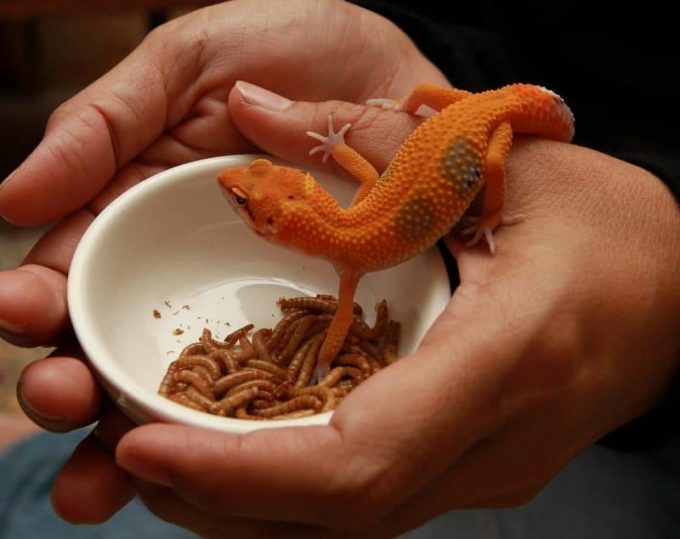
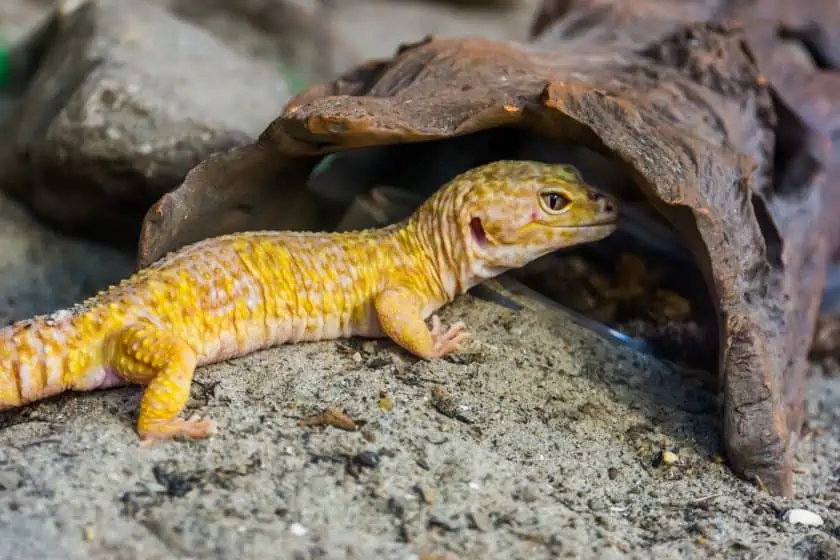
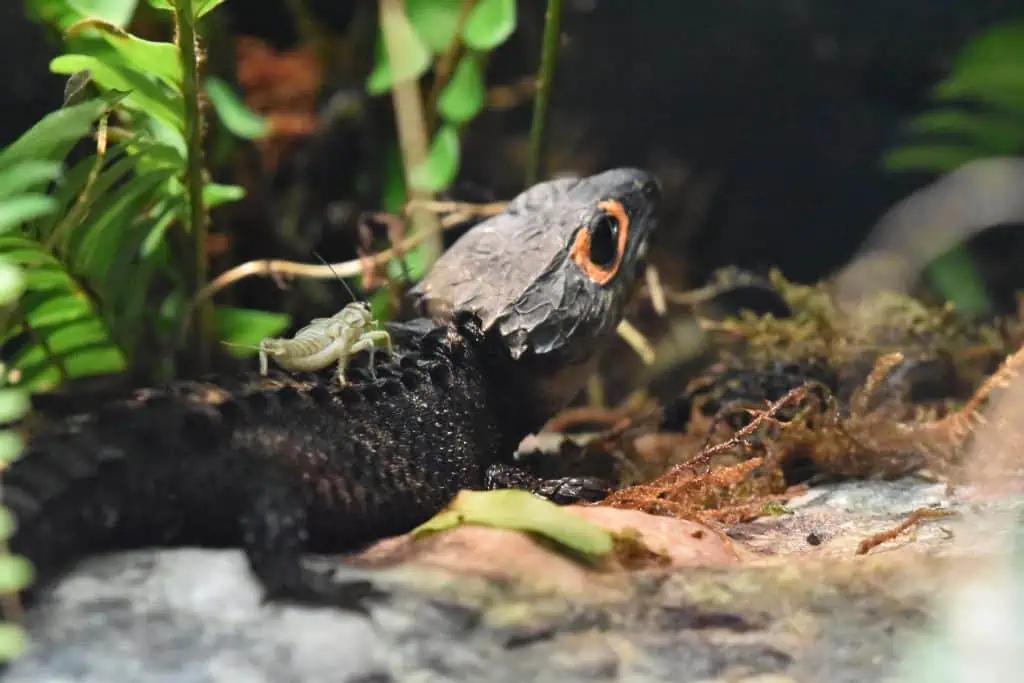
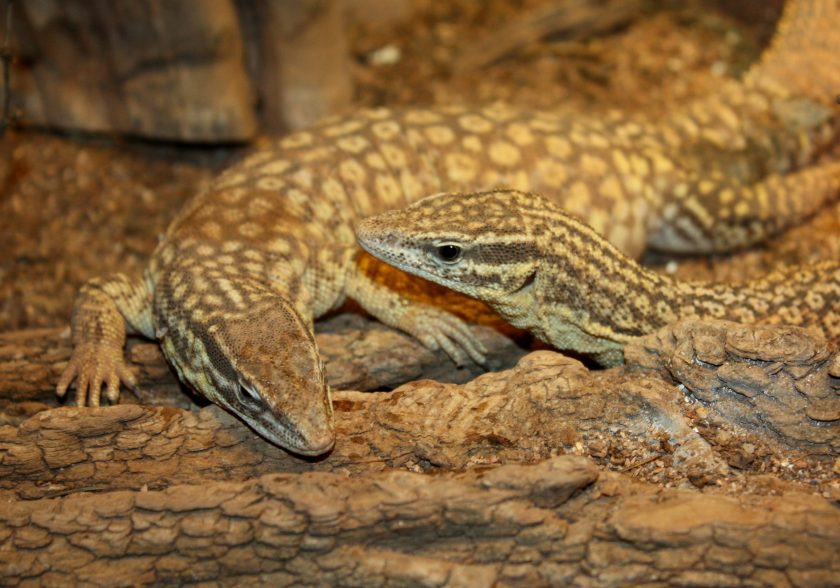
7 Comments
Thanks for the article. I’d love to have a Beardie but my Rottweilers have a bit of prey drive and I would hate to have something happen to lizard , or have to keep them separated and feel like anyone were being neglected. It’s unfortunate because Beardies seem to be really cool pets with good personalities. Since I can’t have a Beardie , I’ve skrt of tamed the 5 lined skinks that hang around the front yard. There are a few that I can hand feed and that will crawl around on my hand.
Hi Felix,
I’m glad you enjoyed the article. It definitely sounds like you would have to keep your dogs and beardie separate but this is the case in many households. Oh nice, 5 lined skinks are cute little guys.
Can you make an arrival on panther chameleon temperament? In some places I have heard they are grumps and in others that they are docile-for a chameleons at least. At some point I’m considering one when I’m older, and I would like to believe (and have heard) that they are friendly for the most part, but grumpy when they just are. So an article about them would be great-I DONT KNOW WHO TO BELEIVE!!!!
That was a great read but I will say that leopard geckos does need to be given uvb that’s my second lizard
Hi Tammy,
Thanks for sharing your experience here!
We wrote an article about the leopard gecko lighting needs, and we talk about UVB light in it: https://www.terrariumquest.com/leopard-gecko/habitat/best-lighting/#Do_leopard_geckos_need_UVB
Hope that helps 🙂
Hey, Tammy.
Many lizards do require UVB lighting, but leopard geckos do not.
Only diurnal lizards have evolved to need to bask in sunlight, thereby forcing keepers to provide a wider light spectrum than normal.
In fact, providing UVB lighting for a nocturnal lizard may be harmful.
Thanks for reading and best of luck!
I love lizard <3